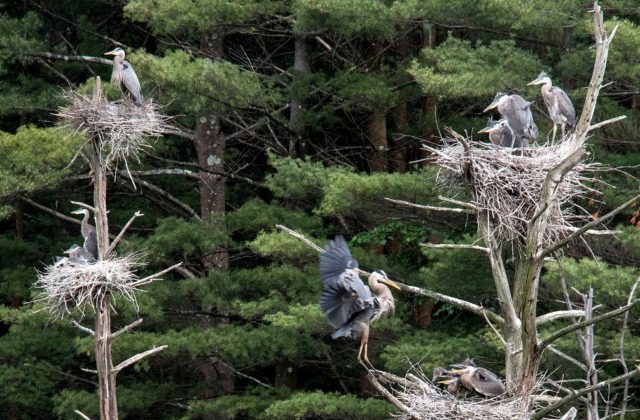What Birds Can Be Found in Norfolk?
Volunteers in Connecticut Bird Atlas Project Collect Evidence
By Shelley Harms
Photo by Bruce Frisch: great blue herons nesting
It is spring, and birds are raising their families, but which birds are bringing up babies here in Norfolk? The bird atlas project currently underway will reveal which birds are enjoying Norfolk alongside us.
Connecticut’s first atlas of birds breeding in the state was based on data collected from 1982 through 1986. At that time, the state was divided into a grid of 596 blocks, and each block was visited by volunteers to generate a list of birds present during the breeding season, along with evidence of breeding. The volunteers who patrolled Norfolk for the original atlas included noted birders Gene Billings, Ayreslea Denny and Dave Rosgen. Their results were published in a book in 1994, titled The Atlas of Breeding Birds of Connecticut.
Now, a second Connecticut Bird Atlas project has begun, to cover the period from 2018 through 2020. In addition to collecting evidence of breeding birds, the new atlas project will measure abundance and will tally species that use the state in winter and during migration. The idea is that knowing where the birds are and what habitats they are using will inform better decisions to protect them.
Volunteer birders signed up to cover blocks and began surveying them in 2018, and the results of the first year’s breeding survey have just been published on the atlas’s website.
Twelve blocks cover Norfolk (and a bit of adjacent communities – the blocks do not exactly match Norfolk’s boundaries). Ten of the 12 blocks have been “adopted” by volunteers including John Anderson, Ray Belding, Nick Bonomo, Buzz Devine, Shelley Harms, Chris Localzo, Suzanne Newell, and Joan Walsh. Volunteers who adopt a block commit to spending at least 20 hours surveying their assigned blocks during the breeding season. But they and anyone else with an interesting observation can report it for any block, not just the block they have adopted.
In the first atlas, 133 species were tallied in Norfolk, and of those, 96 species were confirmed breeders. To confirm breeding there must be strong evidence, such as an occupied nest, carrying nesting material, or feeding young. So far in the second atlas, 63 species are confirmed to be breeding in (or just outside) Norfolk.
As with some human Norfolk residents, many bird species have been raising their families here for generations. Fifty-seven of the species confirmed breeding in the 1980’s were also confirmed in 2018. These were: great blue heron, Canada goose, wood duck, mallard, hooded merganser, common merganser, Coopers hawk, red-shouldered hawk, broad-winged hawk, wild turkey, mourning dove, barred owl, ruby-throated hummingbird, yellow-bellied sapsucker, downy woodpecker, hairy woodpecker, eastern wood pewee, eastern phoebe, great crested flycatcher, eastern kingbird, tree swallow, barn swallow, blue jay, American crow, black-capped chickadee, tufted titmouse, white-breasted nuthatch, house wren, eastern bluebird, veery, American robin, gray catbird, cedar waxwing, starling, blue-headed vireo, red-eyed vireo, yellow warbler, chestnut-sided warbler, black-throated blue warbler, black-throated green warbler, black and white warbler, American redstart, Louisiana waterthrush, common yellowthroat, Canada warbler, scarlet tanager, northern cardinal, rose-breasted grosbeak, chipping sparrow, song sparrow, dark-eyed junco, red-winged blackbird, common grackle, brown-headed cowbird, Baltimore oriole, house finch, and house sparrow.
But six species that were confirmed breeders in the first atlas were not even seen in 2018. Birds that bred in Norfolk in the 1980’s but were not seen in the 2018 breeding season are killdeer, olive-sided flycatcher, acadian flycatcher, eastern meadowlark, mockingbird, and pine siskin. Have they found that the habitat in Norfolk is no longer to their liking? Or have the volunteers just missed them thus far in the survey?
On the other hand, six species that were not confirmed as breeding in the 80’s have been confirmed now: common loon, red-tailed hawk, common raven, blackburnian warbler, purple finch, and indigo bunting. These species were all here in Norfolk in the 1980’s, but volunteers did not observe behavior that confirmed breeding then.
Of the confirmed breeders in 2018, the most widespread species are Canada goose – confirmed in six blocks – barn swallow – confirmed in five blocks – and six species confirmed in four blocks – robin, starling, chipping sparrow, wood duck, wild turkey, and yellow-bellied sapsucker. The lowest number of species observed in a Norfolk block was 22, while the highest number was 85 species seen in the block that covers much of Great Mountain Forest.
State-wide, preliminary trends show good news for osprey and ravens, which have expanded their breeding ranges and are much more abundant in Connecticut than they were thirty years ago. A species that appears to be showing a marked and unexplained decline in the state is screech owl.
To see more information and keep up with the bird atlas, visit their website at ctbirdatlas.org. If you are interested in adopting a block, blocks 18B (including Botelle School and most of the Norfolk Land Trust’s Pine Mountain) and 18C (including Dennis Hill state park and west to Meekertown) are still available. You can also report your sightings – especially actual nesting –without adopting a block.

